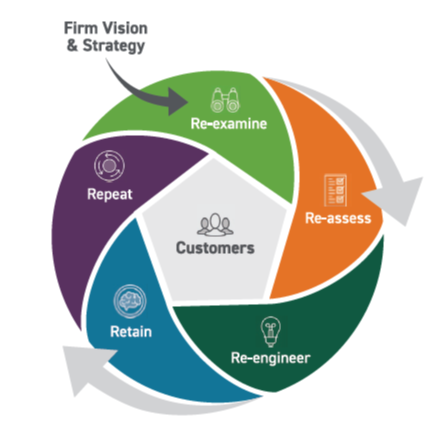Digitally Transforming your Mid-Sized Business for Growth & Profitability
Digitalizing a business requires transforming the entire business model, using software as the core to the firm’s competitive advantage, customizing the go-to-market approach, scaling offerings or services, and upgrading the operations and technology infrastructure. A recent Harvard Business Review article reports that only eight percent of companies believe that their current business model will remain economically viable if their industry keeps digitizing at its current course and speeds.
Prior to the pandemic, technologies such as Artificial Intelligence (AI), Robotics Process Automation (RPA), Internet of Things (IoT) and many others, were already being adopted by most businesses. The pandemic has accelerated the pace of change as customers leverage technology to meet their needs and employers to empower their employees to be more effective working remotely. We believe that the current market conditions provide mid-tier firms a “once-in-a-lifetime” opportunity to take strategic risks to grow revenues and gain market share, by nimbly meeting evolving customer needs, expanding their go-to-market footprint, and competing more effectively with some of their larger, less agile, competitors. At the same time, opportunities exist to optimize business operations and talent models to improve profitability. Leveraging Cherry Bekaert’s proprietary “5R” process can help leaders digitize their business and position it for continued profitable growth.
The 5R Process to Digital Transformation

1. Reexamine – The first step is to conduct an “outside-in” analysis. Begin by reexamining the business environment to identify shifts in customer needs, competitive landscape, regulatory environment, new technologies, etc., and their impact. Ascertain whether these market shifts provide an opportunity or a risk to the business and how to best leverage them to your advantage. Businesses need to relentlessly focus on understanding consumer needs and identifying optimal ways to meet them.
2. Reassess – Next, perform an “inside-out” assessment. Reassess the firm’s vision and mission. Remember that digital transformation is driven by the firm’s strategy and is a subset of it. Examine the firm’s product/service offerings, including the technologies used to develop and support them, go-to-market strategy (customers, sales channels, sales team, products/services) and how they have been impacted by the current market conditions. Review business operations, and talent skills and capabilities to determine the changes that are needed to continue to grow the business. Evaluate all the enabling functions to identify areas for improving margins. In addition, review all knowledge and data needs. Essentially, businesses need to create a digital transformation roadmap.
Digital transformation is a multi-year journey that requires ownership at the highest levels of the organization and significant investment.
3. Re-engineer – A critical step in digital transformation is configuring the business for success. Each firm’s digital transformation journey is unique and will be determined by its current business and industry situation. Some tactical steps include:
- Product/services offerings – Examine the existing product/services being offered, and identify what changes are needed to increase customer retention and grow the customer base. Determine additional service offerings and identify opportunities to move to a “productized” or a recurring revenue model. New solutions and offerings or a recurring revenue business may require different technologies.
- Go-to-market strategy – According to a Bain study, increasing customer retention rates by 5% increases profits by 25% to 95% (1). Traditionally, leaders tend to focus on organic growth, which involves making their business development and sales force teams more effective to grow revenues through customer segmentation, setting revenue targets, establishing KPIs for calls/sales ratios, revenue targets, service metrics, etc. Firms leverage marketing through various channels and social media to reach customers. It is critical to align and optimize the sales force, customer support and marketing teams. Today, leadership has three additional options for inorganic growth: build, buy, or form strategic alliances; each option has its pros and cons, and requires significant time and effort to execute effectively.
- Business Operations – Most firms require several functions to effectively run the business, such as operations, finance, legal, risk and regulatory, procurement, technology support, real estate, knowledge management, etc. There are now alternate approaches to business operations, with providers offering these functions “As-a-Service.” In addition, there is experienced talent available for “fractional” business and operations roles. Leadership should examine how each of these areas has been impacted and determine the approach they want to take to run more efficiently and cost-effectively (i.e. whether they need to be onsite/offsite, in a shared service center, outsourced to a low-cost provider or sent out as a managed service, etc.).
Digitizing a business will require changes in these four areas:
- Processes – Divide the processes into high-value-added, judgment-based tasks, and low-value-added, mundane, repetitive tasks. For time-consuming repetitive tasks, create a journey map to determine how each task or the entire operation could be optimized. Determine whether it can be automated; combined and delivered through a shared service center; outsourced to a low-cost provider; sent to managed service provider or a combination of the above.
- People – Recognize that transformation is about people. Treat the talent in the organization as partners and customers. They are partners in the transformation journey, as they are closest to the business, bring deep insights into processes, recognize pain-points and can often provide solutions. They are also the customers, who will use the new processes, tools, and technologies and will ultimately drive the success (or failure) of the transformation efforts; they need to own the transformation. Leadership will need to take a hard look at the business leaders and firm professionals to determine if they have the right talent in place and determine ways to hire new talent, retrain existing talent or leverage alternate talent models, i.e. gig workers, fractional talent, etc.
- Technology – Digitizing the business will likely require significant technology investments as the business moves to a productized or repeatable revenue model. Examine the current technologies used within the group, how effectively they are used and how they operate within the organization’s larger technology ecosystem. Determine the additional technologies, tools, or services needed to run the operation in the future. In addition, security. Privacy and analytics will play a critical role to be able to offer customized offerings to clients in a secure environment.
- Culture – Businesses often tend to forget the importance of culture. The key to remember is that digital transformation is not done at the center, it is done at the “edges,” by the people closest to the customer. Leadership must create a culture of innovation that promotes the professional’s ability, willingness and potential to innovate, and provides them with the relevant tools, techniques and support systems.
The key is to generate some quick wins, leveraging an agile development process to co-create Minimum Viable Products (MVPs) with customers/end users, testing, iterating, and piloting, before launch, to maximize the impact to the business.
4. Retain – Once the transformation is completed, leadership should retain the new processes, talent and operating models established to continue to reap the benefits from the digital transformation, while keeping a lookout for additional areas of improvement.
5. Repeat – Establish a process for continuous success. As the pace of change accelerates, leadership will need to continue to reassess and reevaluate their strategy and approaches to meet changing market and business needs. Historically, firms developed three to five plans and strategies. Now best practices dictate that organizations, at a minimum, review plans quarterly and update annually. In a time of rapid, unplanned and uncertain changes, resiliency of the organization relies upon reviewing plans and action items more frequently, monthly or even weekly.
Leadership needs to recognize that digital transformation requires different skills, capabilities and expertise, from running “business as usual,” and it is key that they identify the right partner and team to drive the transformation. Business transformation is a complex, messy and iterative process with journeys unique to each organization: there is no “one size fits all.” The benefits of the transformation could take a long time, during which the leadership team may face resistance from the naysayers. The goal for leadership is to bring others within the organization along on the journey and secure their buy-in and ownership to transform the business. In the current market environment, business-as-usual is no longer an option.
We Can Guide You Forward
For more information on navigating digital transformation, please contact us.
References:
1The Value of Keeping the Right Customers, by Amy Gallo, Harvard Business Review, Oct 29, 2020




